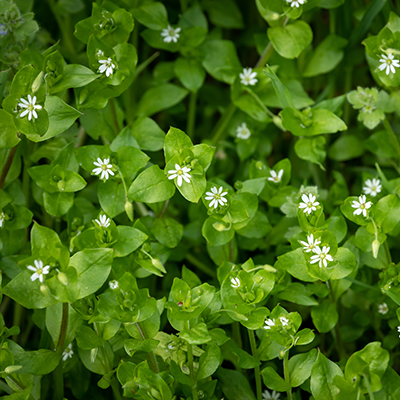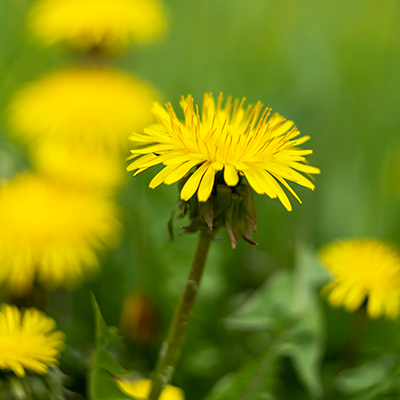Spring: when a young person’s fancy turns to thoughts of love and weeds surge into your yard. The cold weather finally lifting may be welcome after a long winter but as the temperatures rise, so too do weed populations. Knowing what to look out for and being educated on the various ways to eliminate them, including through weed control, will go a long way toward helping you keep your grass, flowers, and other plants safe. So without further ado, let’s get to check out a few!
Springtime Weeds in Indianapolis
Each region of the country has native weeds, some of which are more widespread than others. The Midwest, of course, is no exception. Despite our cold winters and cloudy skies, the Indianapolis region plays host to its share of nuisance spring yard weeds, including:
Broadleaf Plantains
One of the more common lawn weeds in both the Indianapolis area and the Eastern United States at large, the broadleaf plantain has disappointingly little in common with its tasty Caribbean cousin. This widespread perennial weed can grow up to 12 inches in diameter, possess bright green oval-shaped leaves with between 5 and 9 vertical veins, and produces a single central flowering spike that can grow to 6 inches tall.
Its wide distribution and vast numbers can be attributed to the broadleaf plantain’s use of the wind as its primary pollination medium and each plant producing as many as 20,000 seeds! It’s little wonder then that they seem to pop up just about everywhere. 
Popular among urban foragers, though, the young leaves are nutritious and edible, high in calcium, and possess as much beta-carotene per gram as a carrot!
Chickweed
Also found more or less everywhere that grass grows in North America, chickweed is a widespread flowering ground cover, similar to clover. Growing in tight clusters, each slender stem can grow up to 16 inches tall and produces a small white flower with five deeply-lobed petals. Unlike some other weeds, chickweed is relatively easy to get rid of on your own as its shallow roots make it easy to pull up.
Chickweed tends to be pollinated by insects and is particularly popular amongst a wide variety of bee, fly, and butterfly species. So while it’s a pain for sure, limited supplies of it in your yard may be useful if you want to create a pollinator-friendly garden.
Clover
Perhaps the most well-known and common weed that we’ll discuss today, you’ve probably seen clover on your lawn before. Easily intensified by its three circular leaves with a distinct central vein, clover rarely exceeds 6 inches in height and can be either vibrantly green or dark purple.
Clover flowers are a favorite of honey bees and can be identified by their thin purple petals and spherical structure. These blossoms will generally appear in late spring or early summer but can occur even earlier during warmer years.
While clover is widely considered a sign of good luck, in our experience, clover is a stubborn lawn weed that resists weed control quite well and is surprisingly resilient given its delicate appearance. That being said, a little clover on your lawn isn’t all bad. Its dense growth can help smother more harmful weeds or even deprive them of the opportunity to germinate altogether. Still, it’s not picky when it comes to stifling other plants’ growth and can easily take over your entire lawn if you aren’t careful.
Cockleburs
As spring begins to transition into summer, you may notice an abundance of cockleburs around your property. Left alone, these native weeds will grow as tall as 4 feet and will grow short, woody branches with broad, green leaves similar to many varieties of squash. Mature plants will develop small, spiky seed pods which can cling to clothing or pet fur when contacted. Troublingly, the seeds, which are toxic to both humans and animals, can lie dormant for up to 3 years, making cocklebur populations difficult to control.
While its roots tend to grow deep, pulling younger plants up by hand has been shown to be effective. Additionally, chemical herbicides and controlled burnings will get rid of more mature specimens. Should you choose either of the latter two options, be sure that they’re being carried out by an experienced professional.
Dandelions
Another well-known and widespread weed here in Indianapolis is dandelions. This flowering member of the carrot family can be identified by its signature yellow flower, long, pointed green leaves, and cotton ball-like appearance as the plant matures and prepares to seed. Like broadleaf plantains, dandelions also spread their seeds on the wind with each flower capable of producing as many as 200 seeds.
Effective dandelion removal is quite difficult. The plant is anchored by a tough taproot which can penetrate as many as 15 feet into the ground under ideal conditions. However, it’s much more common to see taproots grow 10-15 inches deep. Still, though, the root’s depth makes pulling dandelions up by hand in a way that will prevent them from growing back nearly impossible. For lasting removal, chemical herbicides are generally considered to be preferable.
Also, like broadleaf plantains, dandelions are both edible and nutritious, with their leaves being particularly prized as a salad green for their zesty and peppery flavor. Dandelion greens are packed full of vitamins A, C, E, and K and calcium, making them as close to a superfood as anything else out there!
Wild Violets
Wild violets may look nice, but don’t let their appearance fool you. Growing low to the ground in tight clusters, wild violets have small, green, arrowhead-shaped leaves and distinctive purple flowers, which make them visible at a distance. Much of their growth takes place underground as they reproduce via rhizome. This also allows wild violets to spread quickly and regrow even after being pulled up.
The best defense against wild violets is a healthy lawn. When healthy, most turfgrasses will create a dense groundcover which can prevent the subterranean rhizomes from sending up their shoots in the first place. Additionally, chemical herbicide-based spot treatments effectively control early growth but should be applied as quickly as possible to help prevent spreading.
Keep Your Indianapolis Lawn Weed-Free With Weed Control From Picasso Lawn & Landscaping
Any proud homeowner or yard enthusiast bristles at the sight of unwanted weeds. Keeping them away, though requires round-the-clock monitoring and a level of commitment that your busy life simply may not allow for. If the extra hours in the day aren’t there, though, don’t worry because we at Picasso Lawn and Landscape are here to help. With our weed control service on your side, you can rest assured that your lawn is in the very best hands. Our industry-leading pre and post-emergent treatments, as well as dependable prevention methods, will keep your lawn and garden safe and healthy all year. So don’t let unwanted weeds gain a foothold in your yard, and get in touch with us today. Reach out to us online or give us a call at 317-253-5296.
For more tips and ideas like the one above, check out our other blog articles here.
